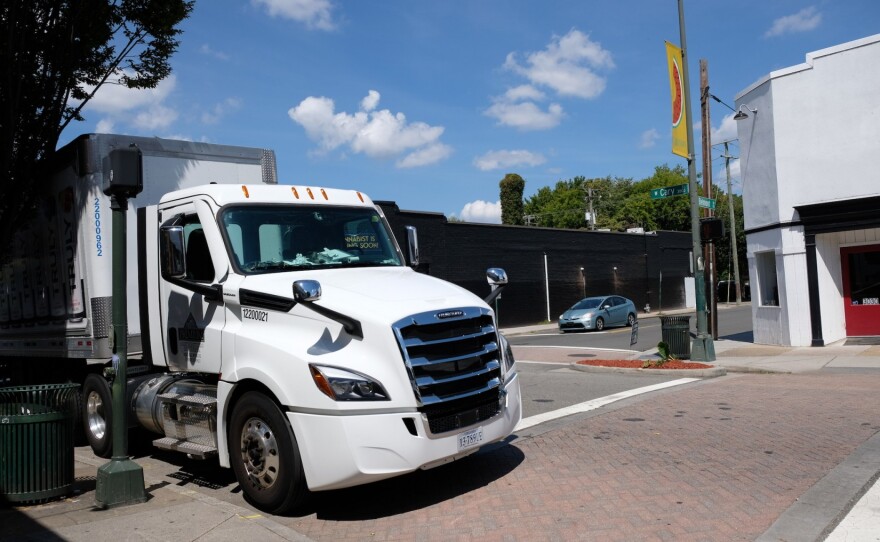The idea of permanently closing Carytown’s business district to cars is nothing new. A Richmond mayoral candidate floated the idea back in 2008. During the height of the pandemic, an online petition was circulated to close the street like many cities across the country did to streets with retail businesses. Some cities saw increases in business because of that decision and kept them closed.
Many locals say now’s the perfect time for Richmond to do the same.
One is Cassi Patterson. She's a transportation planner for a civil engineering firm in downtown Richmond and the co-chair of the Safe and Healthy Streets Commission in Richmond.
“It's not really a pedestrian-focused street, it’s a car-centric street with people on it,” Patterson said. “I think cars are inhibiting Carytown. Honestly, I think it's concealing the businesses.”
She said if Carytown were to remove cars from the equation, the main benefit would be safety.
“It would also probably attract a lot more people to the area,” Patterson said. “[But] I don't know if it's feasible in the near future. I think we would need a lot of study to make sure that it's not going to have a negative impact on the surrounding streets before we do that.”
The retail district spans several blocks of Cary Street from Thompson Street to Arthur Ashe Boulevard. Carytown Court, which is roughly in the middle of the district, opened in 1938 and was the city’s first strip mall, according to the Valentine Musuem.
The rest of Cary Street is filled with a rotating list of restaurants and shops that have opened and closed over the years. A few mainstays include Plan 9 Records, the Byrd Theater, Babes of Carytown and World of Mirth.
Shops like these are one reason Wendy Lusk visits Carytown on a regular basis.
“I come to Carytown to shop because this is one of the last remaining places where you have independent stores, mom-and-pop shops, which is very special in an age where you have a ton of strip malls,” said Lusk, who added that she often brings out-of-towners to the street to shop.
Lusk said it would be advantageous to close Cary Street to cars as long as there’s ample parking somewhere nearby.
“I’ve seen too many close calls with families and children,” Luskc said. “Cars do drive pretty quickly. It’s hard to see because it’s a narrow street, and I just think it would be safer and promote a more pleasant atmosphere to families, who I see visiting all the time.”
According to the Virginia Department of Transportation, more than 7,000 cars go through Carytown’s retail district daily. So far in 2022, there have been 12 crashes on Cary Street, between Thompson Street and Arthur Ashe Boulevard. Three people were injured in two crashes — one of which involved a cyclist. One crash involved a commercial vehicle. In 2021, there were 23 total crashes.
“All you have to do is walk around Carytown on a weekend day and just watch pretty much any intersection,” said resident Doug Allen. “You’ll see dozens of pedestrians either nearly getting hit or getting bullied in the crosswalk. Basically, just being threatened by drivers using their cars.”
He said events like the city’s annual Watermelon Festival, which closes parts of Cary Street to traffic on a Sunday in late August so people can walk freely in the middle of the street, that make him wish the street could be closed permanently.
“I know that people love their cars, it's very convenient,” Allen said. “But when you see something like the Watermelon Festival, where you just see how usable and how accessible it is when there's not a bunch of cars streaming through the neighborhood, that's really a good kind of pilot for seeing how the neighborhood can work, when it's just a pedestrian mall.”
To promote the idea, Allen created T-shirts with the slogan “Cars Ruin Carytown,” to wear at this year’s Watermelon Festival. Allen originally ordered just a few, but then his friends got wind of the logo and shirt and started demanding their own. Allen decided to sell the shirts as a fundraiser to benefit RVA Community Fridges. His initial goal was to sell 50 — he topped that by selling 78, raising $1,100.
Both Allen and Patterson mention Charlottesville’s downtown pedestrian mall when talking about how Richmond’s Carytown could look.
The idea to close Charlottesville’s Main Street to cars came during a 1959 subcommittee meeting of the Chamber of Commerce, according to Cville-pedia. It took years of studies, planning, money and wading through opposition, but the mall opened in 1976.
“The construction was disruptive. There was sort of a larger economic malaise in cities at that time,” said Lyle Solla Yates, chair of the Charlottesville Planning Commission. “A lot of this was sort of the time of ‘[white] flight and suburbanization,’ which were pretty steep headwinds to go against. But we held firm when many other pedestrian malls failed and became ripped up and became parking.”
Solla Yates said the Downtown Mall is a success story, but it had its share of troubles throughout the decades. If Richmond were to close Carytown to cars, he does have some advice for city planners.
“Throw money at it, and hire professionals to do it, right,” he said, adding that Charlottesville used federal and state grants to build its pedestrian mall. “It is very tempting to just kind of throw up some dollars or whatever and do it cheap, but it won't be the same quality space, it won't have the same quality materials, it won't work in the same way.”
What would it take to transform Cary Street?
Inside the Richmond 300 master plan, which is the adopted road map to how the city could look in 2037, it states that areas such as Carytown could see either permanent or temporary street closures if the city expands and improves bike-walk streets.
Richmond city council member Stephanie Lynch, whose district includes Carytown, said in an email to VPM News:
“I personally would love to see open streets in Carytown and other business districts. I do believe resident and business buy-in along with parking infrastructure would be required … But it’s important to look ahead towards a world where roads do no[t] exist solely to accommodate cars. It’s a culture change but our city roads can and should accommodate all modes of [transportation], to include walking, biking, buses and other multi-modal options.”
Members of the Carytown Merchants Association told VPM News in an email there’s a lot of issues to address before any permanent closure could happen. The emailed response had quotes from business owners but did not specify which business or owner were supplying the quotes.
Issues cited include ensuring access for people with disabilities and improving alleyways to accommodate larger truck deliveries.
“There's a reason why you are blocked constantly by food, beverage, and freight trucks. Our alley structure is completely different from other areas, and they are unable to navigate through the turns to hit the businesses,” one of the responses said.
Parking is one of the organization’s biggest concerns.
“It's already tight as it is, and people want to be able to park and walk. We would need to build up the current structures to accommodate heavier traffic; you can't even turn around on the bottom floor once you enter. Charlottesville and other areas have parking around the area that you can use easily, this would force parking into the residential area that is already tight,” another response said.
Three GRTC bus routes (5, 20, 78) run through Carytown. In 2021, the three routes combined saw a total of 927,940 riders, though that number includes the entire routes, not just Carytown.
One of those riders is Clover Dosier, who was waiting near the corner of Sheppard and Cary streets to catch the 5, connect to the Pulse and get to the Montrose line, he said. The bus stop was partially blocked by a delivery truck.
Dosier is a frequent bus rider. Many times, he has to navigate getting on the bus because cars and delivery trucks are parked at bus stops. He also said it would be safer for everyone if Carytown was closed to cars and buses.
“As a bus rider, even if they’d move the stops, I could just walk another block. It’s no problem,” Dosier said. “This bus is on a half-hour delay, and I suspect that just happens all day long because we see cars coming out, pedestrians crossing. There’s just too much stuff going on right here on this strip.”
Adrienne Torres is the chief development officer for GRTC. She said because they already adapt for events like the Watermelon Festival, they’d still be able to operate if Carytown was closed to traffic. But they’d have to work with city officials from the start.
Torres said one possibility to make the GRTC flow smoother if Carytown were closed would be to change some one-way streets to two-way.
“Whatever happens, just include transit in it,” she said. "Don't think of us as an afterthought but incorporate us in the actual planning so that people can still get to this area that is pedestrian only when they don't have cars,” she said.
Patterson, the transportation planner, said several steps must be taken before the area could be closed to cars completely, including ensuring the surrounding streets are adequately prepared for additional traffic diverted from Cary Street.
But she said the city could start with baby steps.
“You could remove the [on-street] parking,” Patterson said. She added that would allow the sidewalks to be extended, giving people room to walk and not resemble a “mosh pit” on weekends.
Patterson said the city could alternatively use the saved space to plant more trees or add a dedicated bike or transit lane. This idea is that cars could still flow through but not stop and park, which often causes back-ups.
W Cary Street (Richmond, Virginia) pic.twitter.com/SuTNAkwlbE
— AI-generated street transformations (@betterstreetsai) July 29, 2022
A Brooklyn-based artist recently made an AI rendering of Carytown without cars.
Nearby resident Flora Dapena walks or scooters to Carytown on a regular basis, but she avoids driving through Carytown because it’s crowded, and she worries about people darting into the street. She said for the most part, the street — with its stores, restaurants with patio seating and sidewalks — looks inviting, but there’s a paradox.
“It has all the ingredients of a really great public space that could be really inviting for tons and tons of people to walk through every day,” she said. “But the sort of paradox of it is that it has a highway down the middle of it. That's what really gets me about this. It has all the bones of an open street already — except for the highway in the middle.”
Dapena says Carytown should go back to its days before its first strip mall to a time when cars weren’t at the forefront of transportation.







